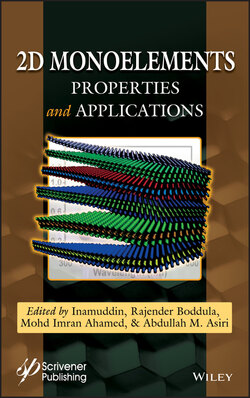Читать книгу 2D Monoelements - Группа авторов - Страница 43
2.1 Introduction
ОглавлениеTwo-dimensional (2D) materials are different from traditional three-dimensional (3D) bulk materials because the movement of charges is confined to the atomic layer, resulting in many novel physical phenomena. As the most typical 2D material, monolayer graphene was successfully isolated in 2004 [1], which paves the way to discover and study more families of 2D materials. However, the valence band intersects the conduction band at the Dirac point [2], making graphene a semi-metallic material with no band gap, which limits its applications in electronic and optoelectronic devices.
Afterwards, many researchers hope to find novel 2D materials with a certain band gap. Transition metal dichalcogenides (TMDs) are also a typical class of 2D materials, these materials have tunable band gap ranging from 1.5 to 2.5 eV and some of which are semiconductors with direct band gap [3]. However, TMDs are still not very suitable for optoelectronic applications. Therefore, other groups of 2D materials have aroused interest in research. Among them, the earliest concerned and widely explored 2D material is black phosphorus (BP), which is the most stable allotrope of phosphorus. The band gap of BP can be adjusted in a large range by the number of layers to achieve light absorption from the near infrared to the visible region. BP also has a high carrier mobility of up to 103 cm2 V−1s−1, and a large on-off current ratio of 105 [4]. Therefore, it is a very promising electronic and optoelectronic materials. In addition, unlike other 2D materials, BP possesses crystal orientation-dependent carrier mobility, light absorption, and other properties as well, due to its anisotropic nature [5, 6]. Unfortunately, a fatal disadvantage of BP is its easy degradation, due to the joint influence of oxygen, water, and light [7].
In view of this, the researchers turned their attention to the other group 15 elements. One of the most representatives is antimonene with strong spin-orbit coupling. In 2015, the novel 2D antimonene was first proposed theoretically [8]. The theoretical studies show that when the antimonene is thinned from bulk to monolayer, the band structure will be abrupt, resulting in its conversion from semi-metal to semiconductor, and the 2D form is still extremely stable. Monolayer antimonene is predicted that having a band gap of 2.28 eV [8]. This makes antimonene very interesting for fabrication in field-effect-transistors (FETs) and optoelectronic devices [9, 10]. At the same time, theoretical predictions have found that Group 15 monoelements have higher carrier mobility [11]. Apart from this, 2D antimonene has also achieved many significant results in experiments. Here, we discuss the research on 2D antimonene in recent years, including four parts as below. Section 2.1 gives the predicted structure and electronic band of antimonene based on the theoretically calculations. Section 2.2 summarizes the experimental synthesis of antimonene with different thicknesses and shapes, including mechanical exfoliation, liquid phase exfoliation, epitaxial growth, and some novel technologies [12]. In Section 2.3, we discuss various potential applications of antimonene, such as nonlinear optics, electrocatalysis, energy storage, biomedicine, and magneto-optic storage. Moreover, a perspective of the future 2D antimonene research is provided in Section 2.4.
